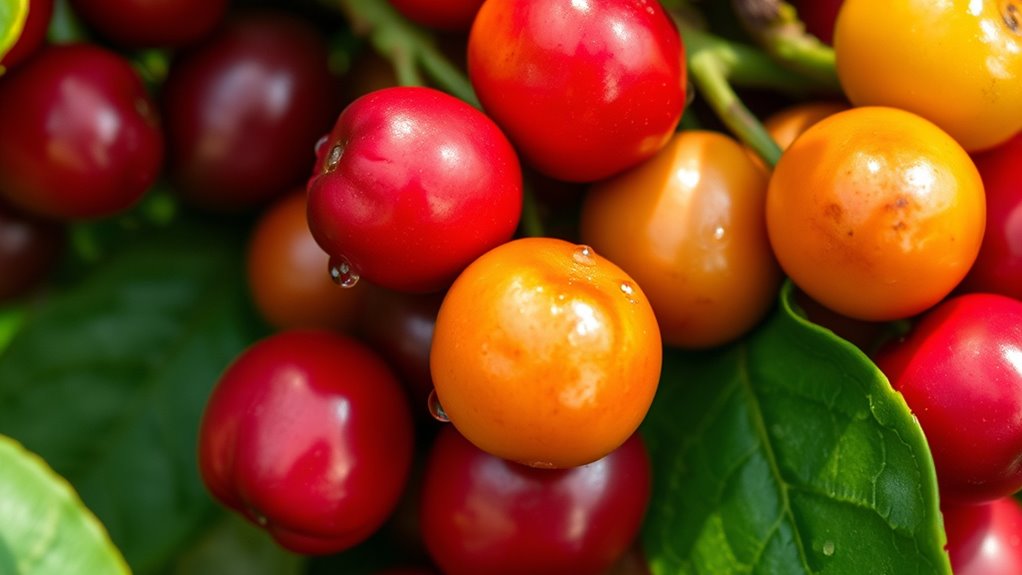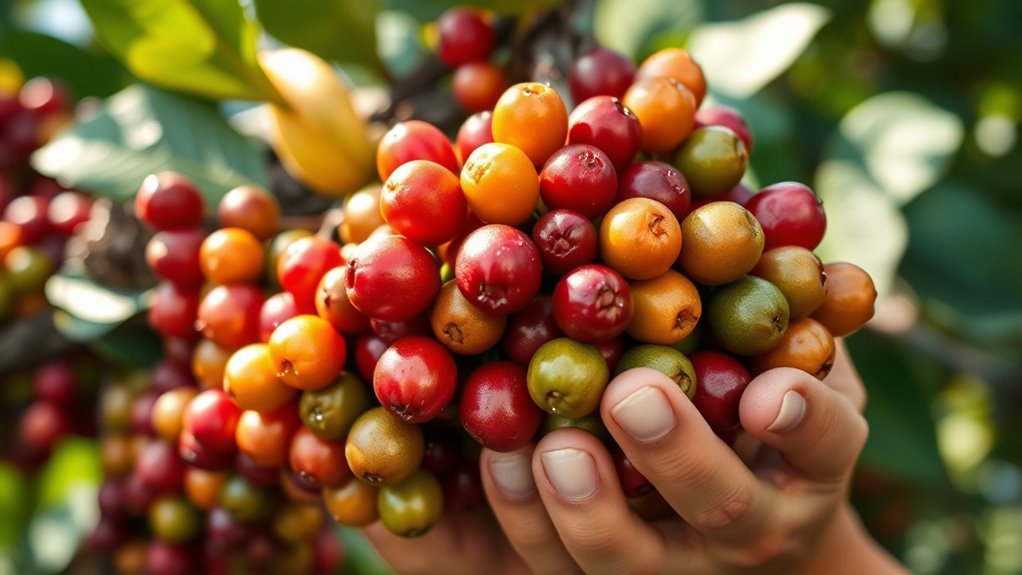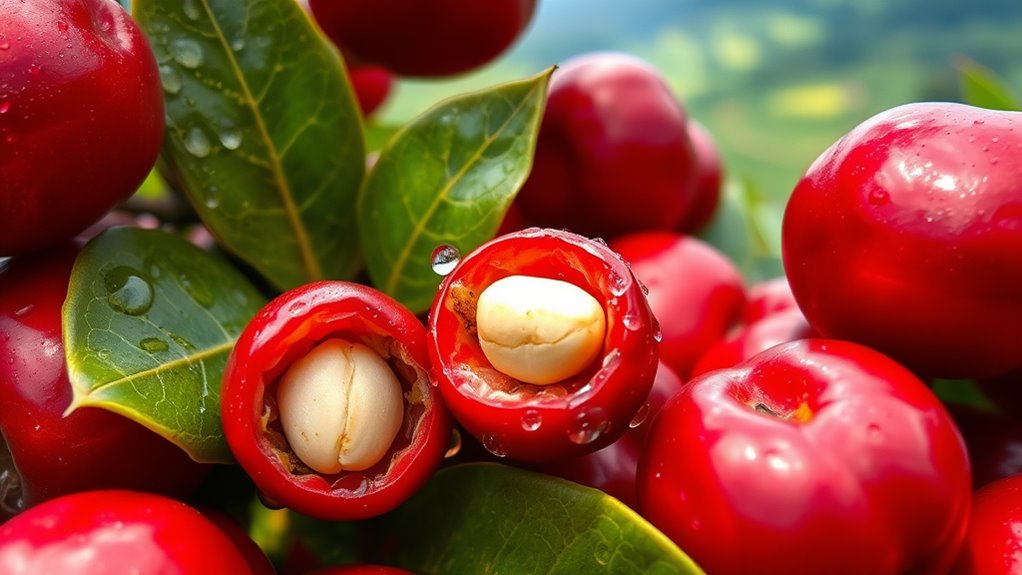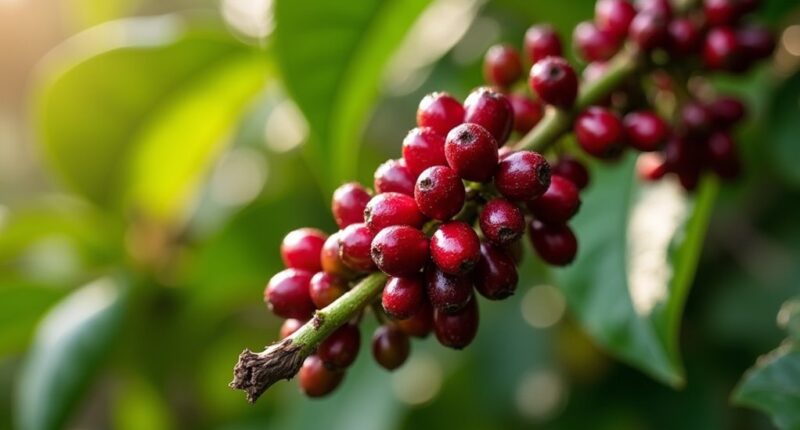So, coffee cherries are those colorful fruits from the Coffea plant that look more like grapes than cherries. Inside, they hide your beloved coffee beans, packed with flavor and caffeine! As they ripen over seven to nine months, they go from hard and green to sweet and red. You can even use the leftover cherry pulp for tasty treats like muffins or tea. Stick around, and you might just discover more fun facts about these little gems!
At a Glance
- Coffee cherries are the fruit of the Coffea plant, resembling grapes more than actual cherries in color and size.
- They contain coffee beans with varying flavors based on ripeness, ranging from sweet to tangy.
- The cherries have several layers: exocarp (skin), mesocarp (flesh), mucilage (sticky layer), endocarp (parchment), and silverskin (bean protection).
- Processing methods, such as natural and washed, significantly influence the flavor profile of brewed coffee.
- Beyond brewing, coffee cherries can be used to make cascara tea, coffee flour, and antioxidant-rich juice.
Definition and Characteristics of Coffee Cherry

Have you ever heard of coffee cherries? They’re not actual cherries, but the fruit of the Coffea plant.
These little beauties come in different colors and sizes, resembling grapes more than cherries. Inside, they hide those precious coffee beans packed with caffeine content!
Depending on the coffee varieties, these cherries can be sweet, tangy, or even fruity like cranberry. The ripening process is essential; you want them deep red for the best flavor.
The flavor of coffee cherries varies, with ripeness key to achieving that deep red, delicious taste.
And guess what? You can even brew the pulp into a tea called cascara. Additionally, the quality of coffee beans is significantly influenced by the environmental factors that affect the flavor profile.
Anatomy and Layers of the Coffee Cherry
When you dig into the anatomy of a coffee cherry, it’s like peeling back layers of a delicious fruit salad!
First up, the exocarp, or outer skin, protects the cherry and shows off its vibrant colors.
Underneath, the mesocarp works its magic, adding sweetness and flavor complexity.
Then comes the mucilage, that sticky layer essential for fermentation—think of it as the cherry’s secret sauce!
Finally, the endocarp, or parchment, keeps the seeds cozy.
Inside, the seed layers, including the silverskin, guard the precious beans.
Each layer plays its part in crafting that perfect cup of coffee you love! The quality of the Colombian coffee beans is often influenced by the specific growing conditions and the care taken during processing.
Ripening and Harvesting Process

As you commence on the journey of coffee cherry ripening, you’ll discover it’s not just a race to the finish line but a delightful marathon that takes about 7 to 9 months. The ripening stages are fascinating, as cherries evolve from hard and green to sweet and red. Harvesting techniques also play a significant role in quality. The best tasting ground coffee often comes from cherries harvested at their peak ripeness.
| Stage | Color | Harvesting Technique |
|---|---|---|
| Early | Green | Strip picking |
| Midway | Yellow/Orange | Manual selective picking |
| Peak | Red | Manual selective picking |
| Overripe | Dark | Strip picking |
| Mixed | Green/Red | Manual selective picking |
Impact of Processing on Coffee Quality and Flavor
Processing coffee is like giving it a makeover, transforming those humble cherries into a delightful brew that can kickstart your day or provide a cozy afternoon pick-me-up.
Different processing methods shape the flavor profiles of your favorite cup. Here’s how:
- Natural Processing: Enhances sweetness and fruity notes.
- Washed Processing: Brings out bright acidity and clarity.
- Honey Processing: Balances sweetness with body and complexity.
Each method affects the final taste, creating a unique experience. The choice of green coffee beans also plays a significant role in determining the overall quality and flavor of the brew.
Uses Beyond Coffee Beans

You might think coffee cherries are just the pretty little fruits that hold those precious beans, but they’ve got a whole life beyond your morning cup!
These colorful gems shine in culinary applications and beverage innovations. Ever tried cascara tea? It’s a sweet, fruity delight that’s nothing like your usual brew.
You can even whip up gluten-free pancakes with coffee flour or add cherry pulp to muffins for a tasty twist. Plus, coffee cherry juice is a health superstar packed with antioxidants! The versatility of coffee cherries showcases how coarse grind is not the only way to enjoy the coffee plant’s offerings.





